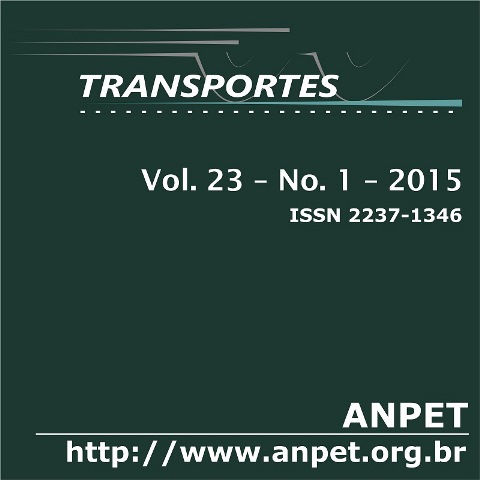Calibración del modelo de capacidad de rotondas del HCM2010 a condiciones locales: caso Córdoba, Argentina
DOI:
https://doi.org/10.14295/transportes.v23i1.832Keywords:
roundabouts, critical gap, follow up time.Abstract
This paper presents the calibration of the relevant parameters, critical gap and the follow-up time, of the roundabout’s capacity model from Highway Capacity Manual (TRB, 2010) to local conditions of the Córdoba Province, Argentina. The field study was developed in four roundabouts. Videotaping was made during rush hour traffic to obtain a representative sample and to calculate the calibration parameters of the model. These are the Maximum Likelihood Method, Linear Regression and Direct Measurement that were chosen as proceedings to estimate their values. It was determined that it is possible to adapt the capacity model from HCM2010 contemplating local driver behavior depending on the parameters. Through comparison with calibrated models in other countries, local drivers have smaller critical and follow-up intervals, which generate a greater capacity at the expense of safety. Local intervals which reflect model’s calibration are proposed.
Downloads
References
ALBRIEU, M. y GALARRAGA, J. (2012) Recomendaciones para la aplicación de la metodología del HCM para intersecciones semaforizadas en Argentina. XVI Congreso Argentino de Vialidad y Tránsito, Córdoba, Argentina.
BRILON, W., KÖNIG, R. y TROUTBECK, R. (1997) Useful Estimation Procedures for Critical Gaps. Proceeding of Third Int. Symposium on Intersections without Traffic Signals, Portland, Oregon, U.S.A. DOI: 10.1016/S0965-8564(98)00048-2
CAIMI, M. (2008) Rotondas: Estimación del Intervalo Crítico y del Tiempo de Seguimiento y su Aplicación en las Medidas de Eficiencia, Disertación Maestría en Ciencias de la Ingeniería Mención en Transporte, Facultad de Ciencias Exactas, Físicas y Naturales, Universidad Nacional de Córdoba, Argentina.
CANAVOS, G. (1988) Probabilidad y Estadística, Aplicaciones y Métodos, Editorial McGraw Hill, México, DF.
DEPIANTE, V. y GALARRAGA, J. (2013) Minor Street Gaps and Capacity at Unsignalized Intersections in Argentina. XIII WCTR, Rio de Janeiro, Brasil.
FLORES CASTELLANO, G. J. (2013) Capacidad de Rotondas: Calibración del Modelo del HCM 2010 a Condiciones Locales. Disertación Maestría en Ciencias de la Ingeniería Mención en Transporte. Facultad de Ciencias Exactas, Físicas y Naturales, Universidad Nacional de Córdoba, Argentina.
GARBER, N. y HOEL, L. (2007) Ingeniería de Tránsito y Ca-rreteras, 3ra edición, Cengage Learning, México, D.F.
GAZZARRI A., MARTELLO M. T., PRATELLI1 A. AND SOULEYRETTE R. R. (2012) Estimation of gap acceptance parameters for HCM 2010 roundabout capacity model applica-tions. WIT Transactions on The Built Environment, Vol 128, WIT Press, ISSN 1743-3509 (on-line) DOI: 10.2495/UT120271
HARDERS, J. (1968) Die Leistungs faehigkeitnicht signal ger-egelter staedtischer Verkehrsknoten (Capacity of unsignalized urban intersections). Strassenbau und Strassenverkehrstechnik, Vol. 76. Bundesministerfuer Verkehr, Abt. Strassenbau, Bonn.
KYTE, M., TIAN, Z., MIR, Z., HAMEEDMANSOOR, Z., KITTELSON, W., VANDEHEY, M., ROBINSON, B., BRI-LON, W., BONDZIO, L., WU, N. y TROUTBECK, R. (1996) Capacity and Level of Service at Unsignalized Intersections. Final Report: Volume 1. National Cooperative Highway Research Program 3-46.
RAFF, M. y HART, J. (1950) A volume warrant for urban stop sign. The Eno Foundation for Highway Traffic Control.
SIEGLOCH, W. (1973) Capacity calculations for unsignalized intersections. Schriftenreihe Strassenbau, Vol. 154.
NCHRP Report 572 (2007) Roundabouts in the United States, National Cooperative Highway Research Program, Transportation Research Board of the National Academies, Washington D.C., USA.
NCHRP Report 672 (2010) Roundabouts: A Informational Guide, Second Edition, National Cooperative Highway Research Program, Transportation Research Board of the National Acade-mies, Washington D.C., USA.
TRB (2010) Highway Capacity Manual. Chapter 21: Rounda-bouts, Volumen 3: Interrupted Flow, Transportation Research Board of the National Academies, Washington D.C., USA.
TROUTBECK, R. (1992) Estimating the critical acceptance gap from traffic movements, Queensland University of Technology, Australia.
TROUTBECK, R. y BRILON, W. (1996) Unsignalized Intersec-tion Theory. Chapter 8, página de internet: http://www.fhwa.dot.gov/publications/research/operations/tft/chap8.pdf
XU, F. y TIAN, Z. (2007) Roundabout Geometric Design Guid-ance. Report N° F/CA/RI-2006/13 California Department of Transportation, Department of Civil Engineering, California State University, U.S.A.
Downloads
Published
How to Cite
Issue
Section
License
Authors who submit papers for publication by TRANSPORTES agree to the following terms:
- The authors retain the copyright and grant Transportes the right of first publication of the manuscript, without any financial charge, and waive any other remuneration for its publication by ANPET.
- Upon publication by Transportes, the manuscript is automatically licensed under the Creative Commons License CC BY 4.0 license. This license permits the work to be shared with proper attribution to the authors and its original publication in this journal.
- Authors are authorized to enter into additional separate contracts for the non-exclusive distribution of the version of the manuscript published in this journal (e.g., publishing in an institutional repository or as a book chapter), with recognition of the initial publication in this journal, provided that such a contract does not imply an endorsement of the content of the manuscript or the new medium by ANPET.
- Authors are permitted and encouraged to publish and distribute their work online (e.g., in institutional repositories or on their personal websites) after the editorial process is complete. As Transportes provides open access to all published issues, authors are encouraged to use links to the DOI of their article in these cases.
- Authors guarantee that they have obtained the necessary authorization from their employers for the transfer of rights under this agreement, if these employers hold any copyright over the manuscript. Additionally, authors assume all responsibility for any copyright infringements by these employers, releasing ANPET and Transportes from any responsibility in this regard.
- Authors assume full responsibility for the content of the manuscript, including the necessary and appropriate authorizations for the disclosure of collected data and obtained results, releasing ANPET and Transportes from any responsibility in this regard.










